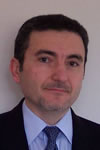FE Issues Related To Creep And Viscoelasticity
A summary report of the FENet Durability and Life Extension (DLE)
workshop in Majorca, Spain, 25th - 26th March 2004.
 By Prof. Adib Becker, University of Nottingham, UK
By Prof. Adib Becker, University of Nottingham, UK
Introduction
Under the FENET technology theme of Durability and Life Extension
(DLE), 6 workshops have been launched to date:
First DLE Workshop:
“Industrial Views on Durability and Life Extension
Issues” (13 November 2001, Wiesbaden, Germany)
Second DLE Workshop:
“Finite Element Simulation of Contact Problems” (27-28
February 2002, Copenhagen, Denmark)
Third DLE Workshop:
“FE issues related to Structural Integrity-Fracture,
Fatigue, and Creep” (13-14 June 2002, Zurich, Switzerland)
Fourth DLE Workshop:
“Finite element simulation of fracture and crack
growth” (11-12 September 2002, Trieste, Italy)
Fifth DLE Workshop:
“Finite Element Simulation of Welds and Joints” (27-28
February 2003, Barcelona, Spain)
-
Discussions in previous DLE workshops have identified the analysis
of creep and viscoelasticity as an important issue across many
industry sectors, and have highlighted several difficulties in
modelling the reallife behaviour of components operating under
elevated temperatures. This DLE workshop aimed to provide a forum
for discussion of the issues relevant to the FE analysis of creep
and viscoelasticity.
Workshop Objectives
The main objectives of this workshop were:
To provide an overview of the current state of FE technology in
applications related to creep, viscoelasticity and high temperature
applications
To identify current limitations and difficulties in modelling
real-life creep behaviour
To provide a forum for discussion of “Guidelines” and
“Best Practice” on using FE in creep and high
temperature applications
To present current techniques for modelling creep damage, crack
growth and creep life estimation
List of Presentations
A total of 5 technical presentations were delivered in this
workshop. Presenters represented university research groups,
industry and FE software vendors.
The following is a list of the technical presentations:
FENET-DLE Workshops - Introduction and Objectives
Prof. Adib Becker, University of Nottingham, UK
Development of a New Material Model for Polymer- Bonded Materials
– An Overview
Dr G.S. Kalsi, AWE, Aldermaston, UK
Modelling Creep of Lead in Water Pipe Joints
Malcolm Toft, Advanced Engineering Solutions Ltd, UK
Creep Simulations with ABAQUS: Super Plastic Forming
Jose L. San-Vicente, PRINCIPIA, Spain
FE Analysis of Creep of welds - Challenges and Difficulties
Prof. Adib Becker, University of Nottingham, UK
Analysis of Workshop
The workshop was chaired by Professor Adib Becker (University of
Nottingham, UK). The main topics covered in this workshop included
the following:
Modelling viscoelastic polymer- bonded materials
Creep stress relaxation and healing effects
Creep of lead pipes at low temperatures
Modelling creep associated with superplastic forming of aerospace
components
Robustness of FE software in modelling high temperature
manufacturing processes
Difficulties in generating creep material properties
FE modelling
Incorporating creep continuum damage in FE software
Benchmarks for creep damage modelling
Creep-fatigue interaction
Discussions were invited after each presentation, with a final open
discussion session held after the last presentation. The workshop
raised many issues related to creep of metals and polymers and
stimulated a number of discussions on the current state and
limitations of commercial FE software.
Concluding Remarks
Reliable creep material properties are not easy to obtain
The creep material properties of narrow Heat-Affected Zones in
welds are particularly difficult to obtain in laboratory tests.
Effects of ageing/degradation of the material are difficult to
measure
To predict creep failure, it is important to understand the creep
failure mechanisms of the material
User-subroutines are often needed to model creep material laws
Creep constants are often very small, e.g. of the order 10-40
Creep continuum damage is not easily incorporated in commercial FE
codes
FE benchmarks for creep continuum damage mechanics are useful in
assessing the accuracy of FE software.

 By Prof. Adib Becker, University of Nottingham, UK
By Prof. Adib Becker, University of Nottingham, UK

